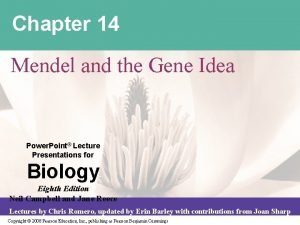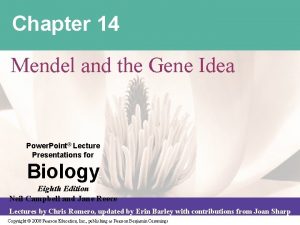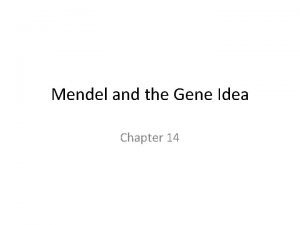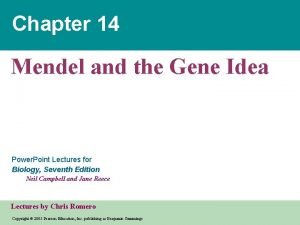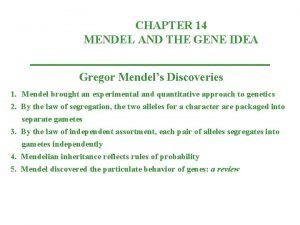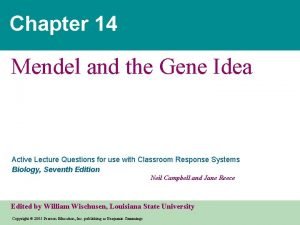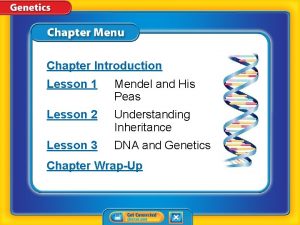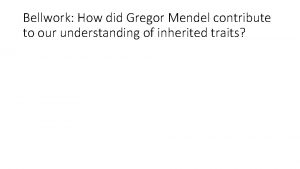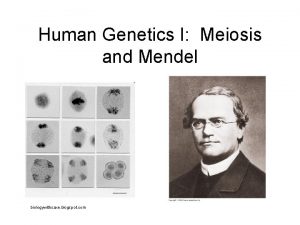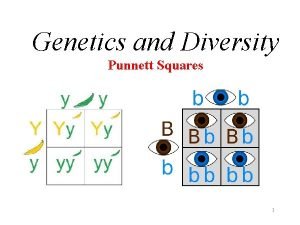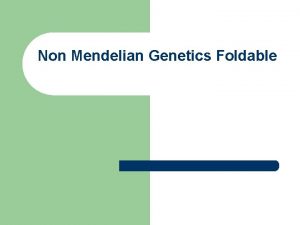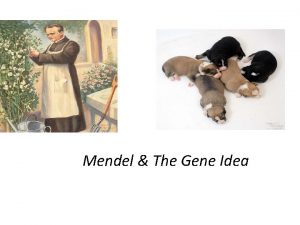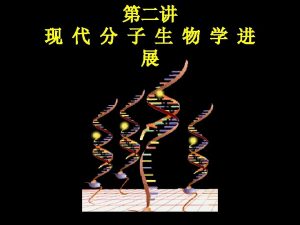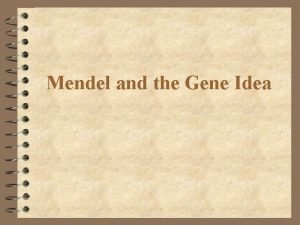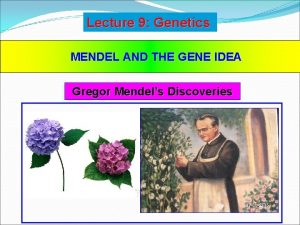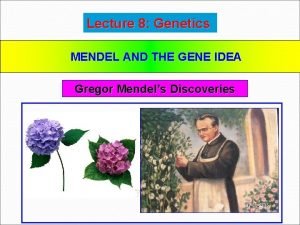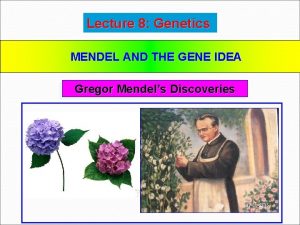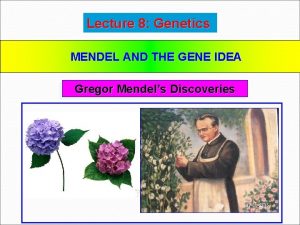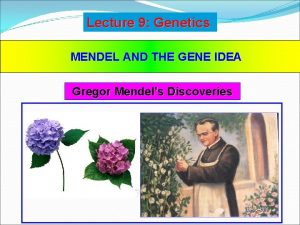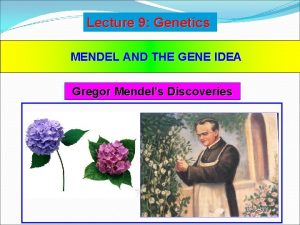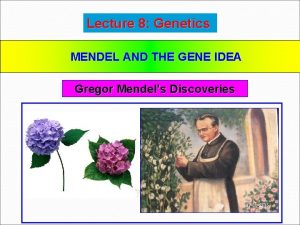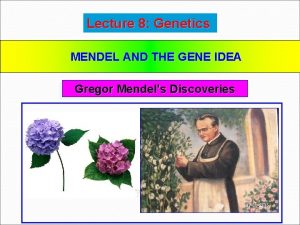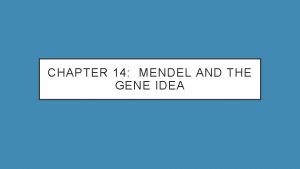Lecture 9 Genetics MENDEL AND THE GENE IDEA













- Slides: 13

Lecture 9: Genetics MENDEL AND THE GENE IDEA Gregor Mendel’s Discoveries

2 - The law of Independent Assortment: ﻗﺎﻧﻮﻥ ﺍﻟﺘﻮﺯﻳﻊ ﺍﻟﺤﺮ ﻟﻠـﭽـﻴﻨﺎﺕ each pair of alleles segregates into gametes independently Mendel’s experiments that followed the inheritance of flower color or other characters focused on only a single character via monohybrid crosses ﺍﻟﺘﺰﺍﻭﺝ ﺃﺤﺎﺩﻱ ﺍﻟﺼﻔﺔ. He conducted other experiments in which he followed the inheritance of two different characters (a dihybrid cross )ﺍﻟﺘﺰﺍﻭﺝ ﺛﻨﺎﺋﻲ ﺍﻟﺼﻔﺔ. In one dihybrid cross experiment, Mendel studied the inheritance of seed color and seed shape. The allele for yellow seeds (Y) is dominant compared to the allele for green seeds (y). The allele for round seeds (R) is dominant compared to the allele for wrinkled seeds (r) Mendel crossed true-breeding plants that had yellow & round seeds (YYRR) with true-breeding plants that has green & wrinkled seeds (yyrr).

The two pairs of alleles segregate independently of each other. The presence of one specific allele for one trait has no impact ﺗﺄﺜﻴﺮ on the presence of a specific allele for the second trait. • When a sperm and an ova each with four classes of alleles combine, there would be 16 equally probable ways in which the alleles can combine in the F 2 generation. • These combinations produce four distinct phenotypes in a 9: 3: 3: 1 ratio. • This was consistent with Mendel’s results. • Each character appeared to be inherited independently.

Mendel’s low of Independent (Dihybrid cross) It is a mating between two parent plants different in two characters. Y R YY RR X yy r r YR y r Y y Rr F 1 Yellow Round

X Yy Rr YR YR Yr Yy Rr y. R yr YYRR Yellow Round Yr YYrr Yellow Wrinkled y. R yy. RR Green Round yr yyrr Green Wrinkled F 2: % of Phenotype ?

Many human disorders ﺃﻤﺮﺍﺽ follow Mendelian patterns of inheritance Thousands of genetic disorders ﺃﻤﺮﺍﺽ ﻭﺭﺍﺛﻴﺔ , including disabling ﺍﻹﻋﺎﻗﺔ or deadly hereditary diseases ﺍﻷﻤﺮﺍﺽ ﺍﻟﻮﺭﺍﺛﻴﺔ ﺍﻟﻣﻴﺘﺔ , are inherited as simple recessive traits ﺻﻔﺎﺕ ﻭﺭﺍﺛﻴﺔ ﺗﻨﺤﻴﺔ. These range from the relatively mild (albinism ﺍﻟﻫﺎﻕ ، )ﺍﻷﻠﺒﻴﻨﻮ to life-threatening (cystic fibrosis). Heterozygotes have a normal phenotype because one “normal” allele produces enough of the required factors (for ( normal trait). A recessively inherited disorder shows up ﻳﻈﻬﺮ only in the individuals who inherit homozygous recessive allele from parents. Thus, individuals who lack the disorder are either homozgyous dominant or heterozygous. Heterozygous member may have no clear phenotypic effects, but is a carrier who may transmit a recessive allele to their offspring. Most people with recessive disorders are born from carrier parents with normal phenotypes. Two carriers have a 1/4 chance of having a child with the disorder, 1/2 chance of a carrier, and 1/4 free.

A- Recessively inherited disorders ﺍﻟﺼﻔﺎﺕ ﺍﻟﻤﺮﺿﻴﺔ ﺍﻟﻤﺘﻨﺤﻴﺔ 1. Cystic fibrosis ( ) ﺍﻟﺘﻠﻴﻒ ﺍﻟﻜﻴﺴﻲ : a lethal recessive disorder One in 25 people is a carrier. The normal allele codes for a membrane protein that transports Clbetween cells and the environment. If these channels are absent, there abnormally high extracellular levels of chloride that causes the mucus coats of certain cells to become thicker ﺳﻤﻴﻜﺔ and stickier ﻟﺰﺟﺔ than normal. This mucus build-up in the pancreas, lungs, digestive tract, and elsewhere favoring bacterial infections. Without treatment, affected children die before five, but with treatment can live past their late 20’s. 2. Tay-Sachs disease ( )ﺍﻟﺒﻠﻪ ﺍﻟﻤﻤﻴﺖ : a lethal recessive disorder. – It is caused by a dysfunctional enzyme ﺇﻧﺰﻳﻢ ﻏﻴﺮ ﻋﺎﻣﻞ that fails to break down specific brain lipids. – The symptoms begin with seizures ﺣﻮﻝ , blindness, and degeneration of motor and mental performance a few months after birth. – Inevitably, the child dies after a few years.

3. Sickle-cell disease ﻣﺮﺽ ﺧﻼﻳﺎ ﺍﻟﺪﻡ ﺍﻟﻤﻨﺠﻠﻴﺔ. It is caused by the substitution of a single amino acid in hemoglobin. When oxygen levels in the blood of an affected individual are low, sickle-cell hemoglobin crystallizes into long rods. This deforms red blood cells into a sickle shape. Doctors can use regular blood transfusions to prevent brain damage and new drugs to prevent or treat other problems. • The two alleles are codominant as both normal and abnormal hemoglobins are synthesized.

B- Dominantly inherited disorders ﺍﻟﺼﻔﺎﺕ ﺍﻟﺭﺿﻴﺔ ﺍﻟﺴﺎﺋﺪﺓ Although most harmful alleles are recessive, many human disorders are due to dominant alleles. 1. Achondroplasia, a form of dwarfism ﺍﻟﺯﻣﻴﺔ , has an incidence of one case in 10, 000 people. Heterozygous individuals have the dwarf phenotype. Those who are not achodroplastic dwarfs are homozygous recessive for this trait. Lethal dominant alleles are much less common than lethal recessives because if a lethal dominant kills an offspring before it can mature and reproduce, the allele will not be passed on future generations.

2 - Huntington’s disease: a degenerative ﻣﻮﺭ disease of the nervous system. The dominant lethal allele has no obvious phenotypic effect until an individual is about 35 to 45 years old. • The deterioration of the nervous system is irreversible and inevitably fatal ﻣﻴﺖ. • Huntington's disease results in an eventual loss of both mental and physical control. • The disease is also known as Huntington's chorea (means "dance-like movements“) refers to the uncontrolled motions.

Many other disorders have a multifactorial basis. ﻣﺘﻌﺪﺩ ﺍﻟﻌﻮﺍﻣﻞ These have a genetic component plus a significant environmental influence. Multifactorial disorders include: heart disease, diabetes, cancer, alcoholism, and certain mental illnesses, such a schizophrenia and manic-depressive disorder. The genetic component is typically polygenic ﻣﺘﻌﺪﺩ ﺍﻟﺠﻴﻨﺎﺕ. At present, little is understood about the genetic contribution to most multifactorial diseases

Summary of the Human Genetic Disorders Autosome - Any chromosome other than a sex chromosome Genetic disorders caused by genes on autosomes are called autosomal disorders v Some genetic disorders are autosomal dominant An individual with AA has the disorder An individual with Aa has the disorder An individual with aa does NOT have disorder v Other genetic disorders are autosomal recessive An individual with AA does NOT have disorder An individual with Aa does NOT have disorder, but is a carrier An individual with aa DOES have the disorder

Definitions v The Law of Segregation v The law of segregation states that a pair of factors is segregated, or separated, during the formation of gametes. v Dominant character (allele) ﺍﻟﺼﻔﺔ ﺍﻟﺴﺎﺋﺪﺓ Is fully expressed in the organism’s appearance. v Recessive character (allele) ﺍﻟﺼﻔﺔ ﺍﻟﺗﻨﺤﻴﺔ Has no noticeable effect ﺗﺄﺜﻴﺮ ﻏﻴﺮ ﻣﻠﺤﻮﻅ on the organism’s appearance. v Homozygous ﺗﻤﺎﺛﻞ ﺍﻟﺠﻴﻨﺎﺕ An organism with two identical alleles for a character. v Heterozygous ﺧﺘﻠﻒ ﺍﻟﺠﻴﻨﺎﺕ An organism with two different alleles for a character. v Phenotype ﺍﻟﻄﺮﺯ ﺍﻟﻤﻈﻬﺮﻱ A description of an organism’s traits (feature )ﻣﻈﻬﺮ. v Genotype ﺍﻟﻄﺮﺯ ﺍﻟﺠﻴﻨﻲ A description of an organism’s genetic makeup.
 Mendel and the gene idea chapter 14
Mendel and the gene idea chapter 14 Chapter 14 mendel and the gene idea
Chapter 14 mendel and the gene idea Chapter 11 mendel and the gene idea
Chapter 11 mendel and the gene idea Chapter 14 mendel and the gene idea
Chapter 14 mendel and the gene idea Chapter 14 mendel and the gene idea
Chapter 14 mendel and the gene idea Chapter 14 mendel and the gene idea
Chapter 14 mendel and the gene idea Chapter 5 genetics lesson 1 mendel and his peas
Chapter 5 genetics lesson 1 mendel and his peas Father of genetics
Father of genetics Gregor mendel
Gregor mendel Chapter 11 biology review answers
Chapter 11 biology review answers How did gregor mendel contribute to genetics
How did gregor mendel contribute to genetics What is independent assortment in meiosis
What is independent assortment in meiosis Phenotype for blue eyes
Phenotype for blue eyes Mendel's genetics foldable
Mendel's genetics foldable
